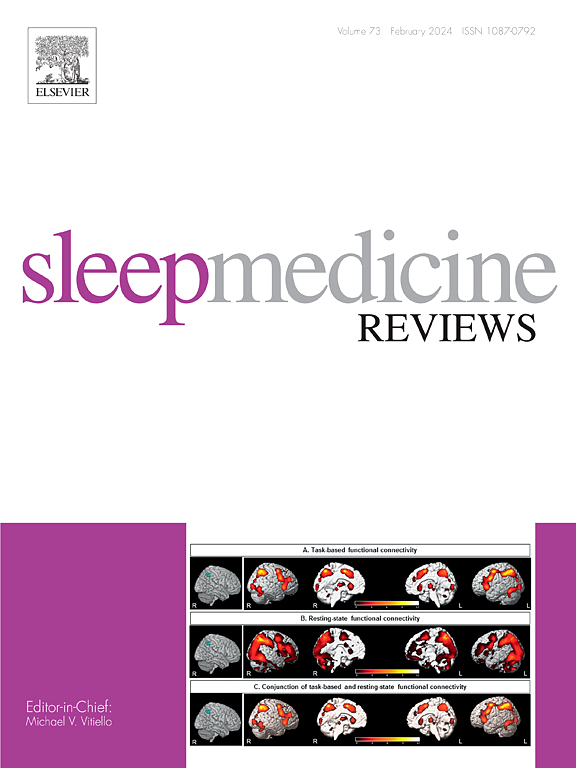Efficacy of mandibular advancement appliances with varying designs in the management of obstructive sleep apnea in children: A systematic review and meta-analysis
IF 9.7
1区 医学
Q1 CLINICAL NEUROLOGY
引用次数: 0
Abstract
Various designs of mandibular advancement appliances (MAAs) have been proposed for managing obstructive sleep apnea (OSA) in children. However, the difference in efficacy between various MAA designs remain unclear. A deeper understanding of the effectiveness of various MAA designs could help refine their design and improve treatment outcomes. This systematic review evaluates the efficacy of different available MAA designs. PubMed, EMBASE, and the Cochrane Library were searched for eligible studies published up to January 2025. A total of 1098 studies were initially identified, from which three randomized controlled trials (RCTs) and five Non-RCTs assessing the efficacy of MAAs in pediatric OSA patients were included. The results showed that MAAs were associated with increased minimal oxygen saturation (SpO2) (CI: 17.67 to −0.82, p=0.03) and mean SpO2 (CI: 1.07 to −0.09, p=0.02) in pediatric OSA patients. The Twin-block appliance did not significantly reduce the apnea-hypopnea index (AHI) (CI: 0.11 to 8.63, p=0.06), while the Mono-block appliance was found to reduce AHI significantly (CI:2.21 to 6.79, p=0.0001). Additionally, unlike the Twin-block appliance, the Mono-block appliance improved both minimal and mean SpO2. With limitation of selected studies, the impact of MAA design on pediatric OSA varied. However, it cannot be concluded that one specific MAA design is superior to others for managing pediatric OSA.
不同设计的下颌推进矫治器治疗儿童阻塞性睡眠呼吸暂停的疗效:一项系统回顾和荟萃分析
不同设计的下颌推进矫治器(MAAs)已被提出用于治疗儿童阻塞性睡眠呼吸暂停(OSA)。然而,不同MAA设计之间的疗效差异尚不清楚。更深入地了解各种MAA设计的有效性可以帮助改进其设计并改善治疗结果。本系统综述评估了不同可用MAA设计的疗效。检索PubMed、EMBASE和Cochrane图书馆,检索截至2025年1月发表的符合条件的研究。最初共纳入1098项研究,其中包括3项随机对照试验(rct)和5项非随机对照试验(non - rct),评估MAAs对儿童OSA患者的疗效。结果显示,MAAs与儿童OSA患者最低血氧饱和度(SpO2) (CI: 17.67 ~ - 0.82, p=0.03)和平均SpO2 (CI: 1.07 ~ - 0.09, p=0.02)升高相关。双块呼吸器没有显著降低呼吸暂停低通气指数(AHI) (CI: 0.11至8.63,p=0.06),而单块呼吸器可以显著降低AHI (CI:2.21至6.79,p=0.0001)。此外,与双块设备不同,单块设备提高了最小SpO2和平均SpO2。由于所选研究的局限性,MAA设计对儿童OSA的影响各不相同。然而,尚不能断定某一特定的MAA设计在治疗儿童OSA方面优于其他设计。
本文章由计算机程序翻译,如有差异,请以英文原文为准。
求助全文
约1分钟内获得全文
求助全文
来源期刊

Sleep Medicine Reviews
医学-临床神经学
CiteScore
20.10
自引率
3.80%
发文量
107
期刊介绍:
Sleep Medicine Reviews offers global coverage of sleep disorders, exploring their origins, diagnosis, treatment, and implications for related conditions at both individual and public health levels.
Articles comprehensively review clinical information from peer-reviewed journals across various disciplines in sleep medicine, encompassing pulmonology, psychiatry, psychology, physiology, otolaryngology, pediatrics, geriatrics, cardiology, dentistry, nursing, neurology, and general medicine.
The journal features narrative reviews, systematic reviews, and editorials addressing areas of controversy, debate, and future research within the field.
 求助内容:
求助内容: 应助结果提醒方式:
应助结果提醒方式:


